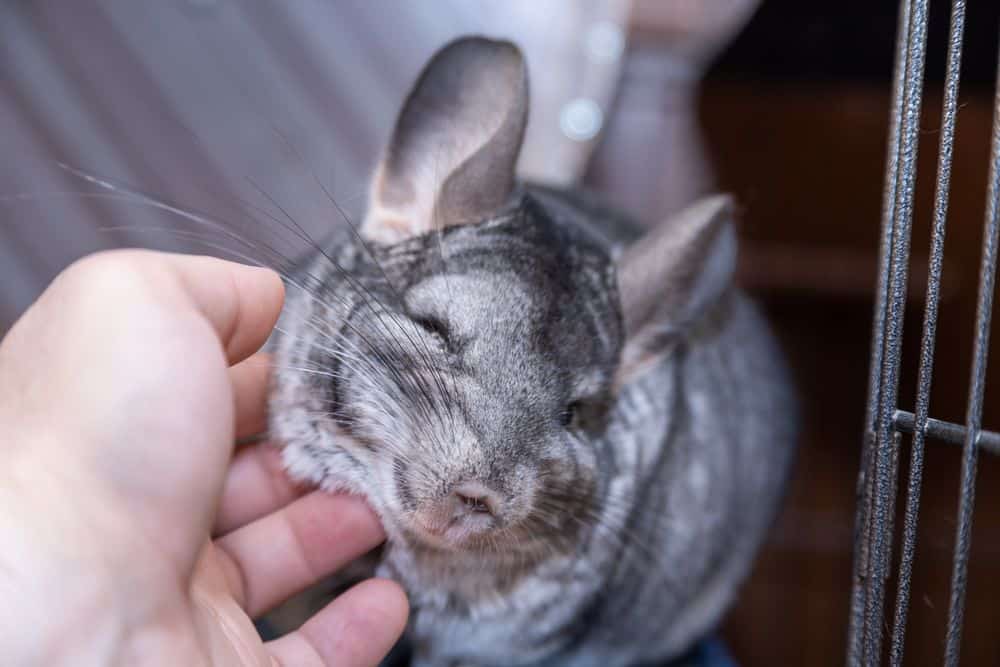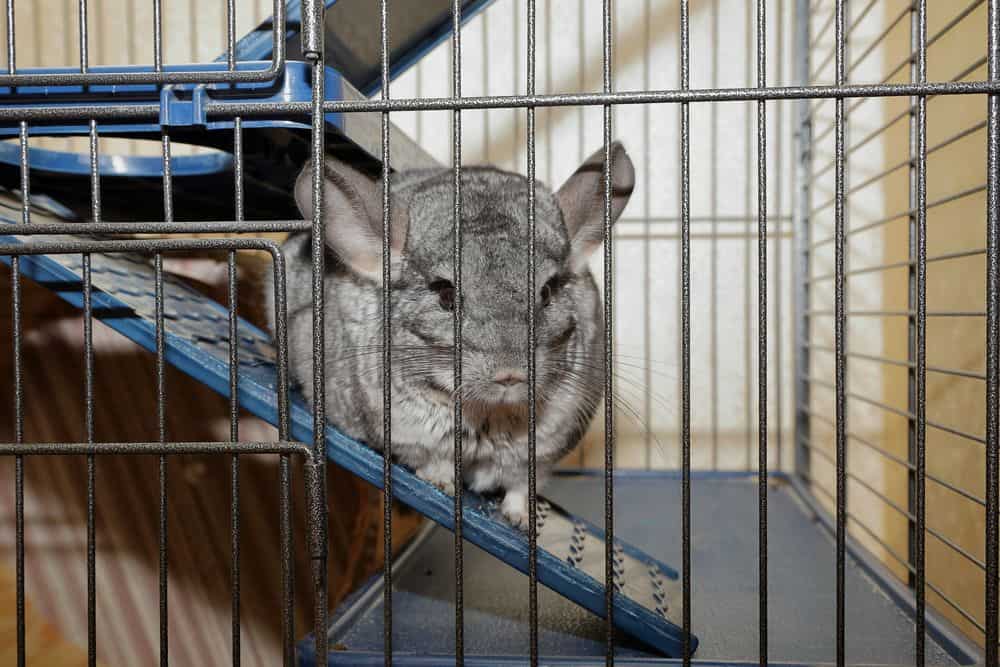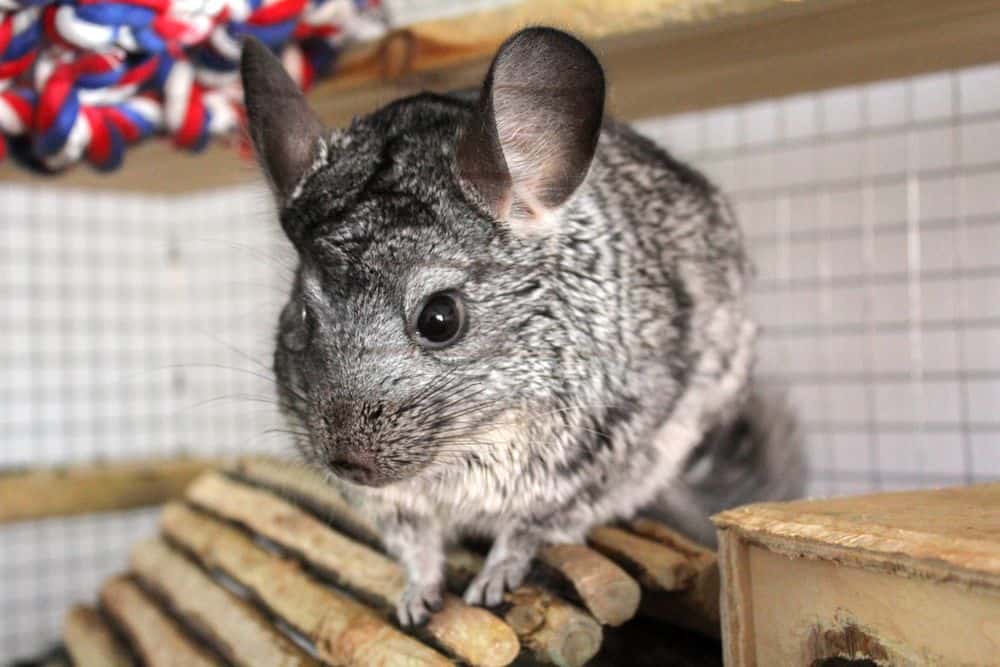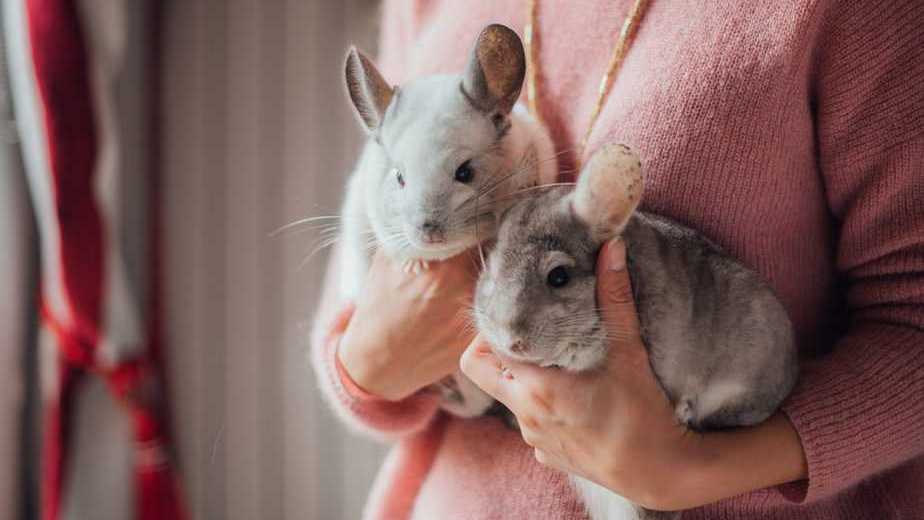
When you bring one into your family, you will witness all sorts of cute behaviors.
One of the cutest is when they nibble your finger. Or even your ear.
It will melt your heart. But it will also leave you wondering: why does my chinchilla nibble me?
Don’t worry, it’s nothing bad. Quite the opposite, in fact!
Keep reading to learn why chinchillas nibble you. We will also look at some other similar behaviors that indicate the same things as nibbling.
Contents
- 1 Why Does My Chinchilla Nibble Me?
- 2 Why Is My Chinchilla Nibbling Me: Final Thoughts
Why Does My Chinchilla Nibble Me?
Your chinchilla might nibble you to show affection, to communicate, or to groom you. Since chinchillas groom each other, nibbling is a way in which your pet tries to ‘groom’ you.
In general, a chinchilla will only nibble or play bite you if it trusts you, is happy with you, and feels relaxed around you. Let’s take a closer look at the 3 primary reasons for chinchilla nibbling.
3 Main Reasons Your Chinchilla Nibbles You

Here are the main reasons your chinchilla might nibble you. Note that we do need to distinguish between nibbling and biting. If your chinchilla is biting, read this article.
Communication
The chinchilla is an intelligent animal. It is not only perceptive, but is also capable of ‘communicating’ with its owners in its own special way.
When you take care of your chinchilla, feed it, play with it, and clean its cage, it forms a bond with you. It also looks up to you as its playmate and caregiver. It might even expect you to do certain things at certain times of the day.
As a result, it may use its special sounds and behaviors to communicate with you. Nibbling is one such form of communication. Chinchillas mainly use nibbling to denote their fondness for you.
To Show Affection
Chinchillas are friendly pets that are capable of forming bonds with their owners. Your chin nibbling on you is a way in which it tries to show its affection and love.
Your little furry pet might even stand on its two legs and try to get your attention. If that does not work, it might use sounds like chirping or barking to get you to come near its cage. And when you do come closer and cuddle it, it might nibble playfully on your finger.
A Form Of Grooming

Chinchillas are social animals that live in herds in the wild and rely on each other for their grooming needs.
Chinchillas have thick coats and by grooming each other, they keep the coat clean and free from parasites. Grooming is also chinchillas’ way of caring for each other and showing their love and affection to their herd-mates.
Since this behavior is hard-wired in a chinchilla’s genes, your pet might use grooming as a way of bonding with you. In captivity, a young chinchilla looks up to its humans as its family members or herd mates and caregivers.
Hence, nibbling on your skin is a way of showing that it wants to take care of you just as you take care of it. And to groom you, it might pick at your skin or nibble and play-bite.
How Can You Tell If Your Chinchilla Is Happy?
In addition to nibbling, several other chinchilla behaviors can indicate happiness. Here are the main ones.
Self-grooming And Grooming Each Other
If you have a single chinchilla, it might groom itself. If you house two or more chins in one enclosure, they might groom each other when they are feeling relaxed, well-fed, healthy, content, and happy.
Coming Up To The Cage Wall To ‘Communicate’ With You

A happy chinchilla will come near the cage walls when you enter the room. It might even ‘rattle’ the cage or climb up to attract your attention. This is a sign that your pet is happy and wants to interact with you.
If you find your chinchilla calling you out with various sounds, make sure to give it the attention it wants.
Yawning
Happy, content, and relaxed chinchillas tend to yawn. However, this is one of those chinchilla behaviors that have multiple explanations.
Chinchillas also sometimes yawn when they are stressed, threatened, or ill. So, do watch out for other signs to determine the exact cause of yawning in your chinchilla.
Interacting With You
A happy chinchilla will try to ‘talk’ with you and interact with you. It may use a series of sounds like squeaking or barking to communicate and interact with you.
Usually, a low, gentle squeaking is an indication that your chinchilla is happy and content. Also, continuous squeaking is a sign of excitement and a chinchilla may use this to show that it is happy to see you.
Active And Energetic

Finally, a happy and content chinchilla will also be active. It will play with its toys, hold it toys or other objects, climb on the perches you have provided in its cage, and explore and search around for treats that you might have hidden in its cage.
How Do Chinchillas Show Affection?
There are several signs of affection that chinchillas may display toward you.
Being Comfortable And Relaxed Around You
Although chinchillas don’t like being handled too much, your pet might still allow you to hold it. This shows that it is comfortable and relaxed around you. It won’t struggle when you hold it
Nibbling Or Grooming You
This is an important sign that your chin likes you and considers you a part of its herd. This is the behavior they use in the wild for their herd mates. Grooming and nibbling each other is a surefire sign of love and affection.
Trying To Get Your Attention

Seeking your attention and trying to get you to come to its cage is another sign of affection from a chinchilla.
No Signs Of Tension
A relaxed chinchilla might yawn and stretch. It might also rest or snuggle in your arms when you’re holding it. This is an indication of a bond of trust between you and your furry pet.
How Do You Gain A Chinchilla’s Trust?
Like any new pet, you need to tame your chinchilla and get it to accept being handled and held. A bond of trust and love between your chin and you can take some time, so be patient.
Start by offering a small piece of a high-value treat to your chinchilla. But be careful not to exceed the daily treat-limit, since chins are prone to obesity. Even seemingly healthy treats like fruits can easily cause weight gain, diabetes, and dental issues in chins.
- Offer no more than one treat per day.
- Limit the handling session to a few minutes each time.
- If your pet refuses the treat, leave it, and try again the next day.
- Soon your chin will jump in your hand and try to eat the treat. This is a sign that it is starting to trust you. It means it is ready to be held and handled.
Every chinchilla is different, so there is no timetable as to when your pet is ready. Some chinchillas may take a few days or weeks, while others may take months to trust you.
What Does Petting A Chinchilla Feel Like?

Petting a chinchilla feels as if you are touching soft, velvety cloth. The reason behind this soft fur is that each hair follicle has 50 hairs growing out of it.
This also makes the chinchilla’s fur very dense and thick. It is also the reason why a chin’s fur should not get wet. Drying chinchilla fur is challenging and the trapped moisture may become a breeding ground for bacteria and fungi.
Young chinchillas have extremely soft, almost cloud-like fur. As they grow older, the fur’s texture may change a bit.
However, healthy chins will still retain the softness of their fur. It should not feel coarse or rough. It should remain soft and velvety all its life.
Why Is My Chinchilla Nibbling Me: Final Thoughts
When your chinchilla nibbles you, it might be trying to communicate with you, trying to groom you or trying to show you affection.
Whichever of the three it is, one thing is certain: when a chinchilla nibbles you, it shows that it feels affection toward you. Isn’t that a wonderful feeling!
Leave a Reply